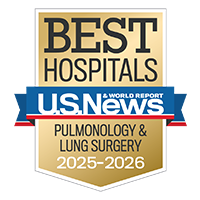Chronic Beryllium Disease

Overview
Chronic beryllium disease, or CBD, causes scarring of the lung tissue. It occurs when a person inhales dust or fumes of beryllium — a naturally occurring lightweight material — and has become sensitized to this material. Beryllium is used in various industries, such as electronics, aerospace, dental, atomic energy and defense.
Our approach to chronic beryllium disease
UCSF provides comprehensive evaluations and care for work-related lung conditions, such as chronic beryllium disease. We offer a wide range of pulmonary function tests as well as flexible bronchoscopy to examine the airways.
Although chronic beryllium disease currently has no cure, treatments can prevent further scarring in the lungs and improve oxygen levels in the blood. These include drugs that suppress the immune system's response to beryllium and devices that deliver supplemental oxygen. Our goals are to slow the disease's progression and help our patients feel better.
Lung transplantation may be an option for severe cases. UCSF is currently the top lung transplant program in the U.S. for higher-than-expected patient survival rates and graft survival rates (ongoing function of the transplanted lungs).
Awards & recognition
-

Among the top hospitals in the nation
-

Best in the West and No. 3 in the nation for pulmonology & lung surgery
Signs & symptoms
In the early stages, CBD may not cause any noticeable symptoms. However, over time, the following symptoms may develop:
- Shortness of breath with physical activity
- Dry cough that will not go away
- Fatigue
- Night sweats
- Chest and joint pain
- Loss of appetite
Diagnosis
In making a diagnosis of chronic beryllium disease, your doctor will start by taking a detailed medical and occupational history and conducting a thorough medical examination. This will help determine if you have been exposed to any toxic substances that may have caused CBD or other occupational lung diseases. CBD, without a specific occupational history and specialized testing, is identical to the disease sarcoidosis and therefore is often misdiagnosed as that condition.
Another important step in making a diagnosis of CBD is a simple blood test called beryllium lymphocyte proliferation test (BeLPT). This test determines if your immune system is reacting to berylium, which may indicate CBD. If you test positive for this test, additional tests may be conducted to make a definitive diagnosis:
- Chest X-ray. A chest X-ray may be taken to look for any abnormalities in your lungs.
- Pulmonary function testing (PFT). This test involves a series of breathing maneuvers that measure the airflow and volume of air in your lungs, which allows your doctor to objectively assess the function of your lungs.
- High resolution computed tomography (HRCT). This is a special type of CT scan that provides your doctor with high-resolution images of your lungs. These images are extremely valuable in determining which type of occupational lung disease you have. Having a HRCT is no different than having a regular CT scan; they both are performed on an open-air table and take only a few minutes.
- Bronchoscopy. This test involves passing a flexible fiberoptic scope, about the diameter of a pencil, into the lungs to obtain fluid and sometimes tissue samples to aid in diagnosis. In evaluating CBD, bronchoscopy usually includes testing a patient's sputum because this fluid can undergo the same beryllium lymphocyte proliferation test (BeLPT) test that is performed on blood.
- Lung biopsy. If a patient's chest X-ray or high resolution computed tomography (HRCT) detects any growths or abnormalities, a lung biopsy may be conducted to determine whether lung cancer is present. A lung biopsy is a surgical procedure in which a specimen of lung tissue is sampled and examined under the microscope.
Treatments
At this time, there is no cure for chronic beryllium disease. However, treatment is available that can help slow the progression of the disease, prevent further lung damage caused by scarring, improve oxygen levels in the bloodstream and manage symptoms.
Treatment depends on the severity of your disease and symptoms and may include the following:
Immunospressive drugs
Prednisone is the immunosuppressive drug most commonly prescribed to patients with CBD. Prednisone slows the immune system's response to the beryllium in the lungs and helps decrease symptoms while improving gas exchange between the lungs and bloodstream. Patients are usually given a course of prednisone that is gradually decreased over a period of time. Over time, however, prednisone can cause side effects. It is important to discuss these side effects with your doctor before starting treatment.
Oxygen therapy
As the disease progresses, patients may find it increasingly difficult to breathe on their own and may require supplemental oxygen. Therapy is delivered in three systems: concentrators, compressed gas systems and liquid systems. The system that best meets your needs will depend on the severity of your disease, lifestyle and where you live. Each system has its own advantages and disadvantages, which you should discuss with your doctor.
Oxygen can be delivered by a number of devices, such as a small plastic tube placed under the nostrils, called a cannula, facemask and Transtracheal Oxygen Catheter, which is a thin tube placed in the neck that delivers oxygen directly to the windpipe. This device is used for continuous, long-term oxygen therapy.
Lung transplant
In severe cases, lung transplant may be recommended.
UCSF Health medical specialists have reviewed this information. It is for educational purposes only and is not intended to replace the advice of your doctor or other health care provider. We encourage you to discuss any questions or concerns you may have with your provider.










